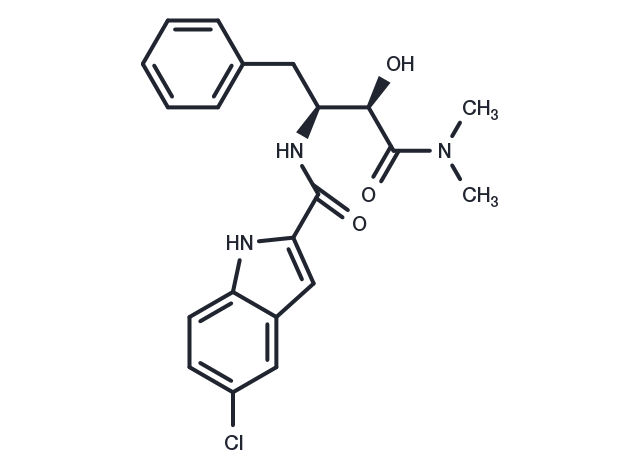Powder: -20°C for 3 years | In solvent: -80°C for 1 year


CP-91149 is a selective glycogen phosphorylase (GP) inhibitor with IC50 of 0.13 μM in the presence of glucose, 5- to 10-fold less potent in the absence of glucose.

| Pack Size | Availability | Price/USD | Quantity |
|---|---|---|---|
| 5 mg | In stock | $ 47.00 | |
| 10 mg | In stock | $ 76.00 | |
| 25 mg | In stock | $ 155.00 | |
| 50 mg | In stock | $ 247.00 | |
| 100 mg | In stock | $ 358.00 | |
| 1 mL * 10 mM (in DMSO) | In stock | $ 52.00 |



| Description | CP-91149 is a selective glycogen phosphorylase (GP) inhibitor with IC50 of 0.13 μM in the presence of glucose, 5- to 10-fold less potent in the absence of glucose. |
| Targets&IC50 | GP:0.13 μM |
| In vitro | CP-91149 displays 200-fold higher inhibitory activity against human liver glycogen phosphorylase a (HLGPa) than caffeine (IC50 = 26 μM). CP-91149 (10-100 μM) inhibits glucagon-stimulated glycogenolysis in isolated rat hepatocytes in a dose-dependent manner, and in primary human hepatocytes with IC50 of ~2.1 μM. [1] CP-91149 also potently inhibits the activities of human muscle phosphorylase a and b with IC50 of 0.2 μM and ~0.3 μM, respectively. CP-91149 treatment at 2.5 μM induces inactivation of phosphorylase and sequential activation of glycogen synthase in hepatocytes, and increases glycogen synthesis by 7-fold at 5 mM glucose and by 2-fold at 20 mM glucose. CP-91149 can partially counteract the effects of phosphorylase overexpression. [2] CP-91149 also potently inhibits brain GP with IC50 of 0.5 μM in A549 cells. CP-91149 treatment at 10-30 μM causes significant glycogen accumulation in A549 and HSF55 cells. CP-91149 treatment increases G1-phase cells with a significant reduction of the S-phase population in HSF55 cells, correlated with increased expression of p21 and p27. [3] CP-91149 also promotes the dephosphorylation and activation of GS (glycogen synthase) in non-engineered or GP-overexpressing cultured human muscle cells, but exclusively in glucose-deprived cells. [4] |
| In vivo | Oral administration of CP-91149 to diabetic ob/ob mice at 25-50 mg/kg causes rapid (3 hours) glucose lowering by 100-120 mg/dl without producing hypoglycemia, resulting from inhibition of glycogenolysis in vivo. CP-91149 treatment does not lower glucose levels in normoglycemic, nondiabetic mice. [1] In the non-fasted Goto-Kakizaki (GK) rats, administration of CP-91149 in combination with CS-917 suppresses hepatic glycogen reduction by CS-917 and decreases plasma glucose more than single administration of CS-917. [5] |
| Kinase Assay | Phosphorylase enzyme assay: Human liver glycogen phosphorylase a (HLGPa, 85 ng) activity is measured in the direction of glycogen synthesis by the release of phosphate from glucose-1-phosphate at 22°C in 100 μL of buffer containing 50 mM Hepes (pH 7.2), 100 mM KCl, 2.5 mM EGTA, 2.5 mM MgCl2, 0.5 mM glucose-1-phosphate, and 1 mg/mL glycogen. Phosphate is measured at 620 nm, 20 minutes after the addition of 150 μL of 1 M HCl containing 10 mg/mL ammonium molybdate and 0.38 mg/mL malachite green. Increasing concentrations of CP-91149 are added to the assay in 5 μL of 14% DMSO. |
| Cell Research | Cells are exposed to various concentrations of CP-91149 for 72hours. Viability is determined with manual cell counts following staining with trypan blue exclusion assay. Cells are fixed with 70% ethanol. DNA is stained with propidium iodide and the intensity of fluorescence is measured using a Becton-Dickinson flow cytometer at 488 nM for excitation and at 650 nM for emission. The cell cycle profile is analyzed using Modifit's Sync Wizard.(Only for Reference) |
| Molecular Weight | 399.87 |
| Formula | C21H22ClN3O3 |
| CAS No. | 186392-40-5 |
Powder: -20°C for 3 years | In solvent: -80°C for 1 year
Ethanol: < 1 mg/mL (insoluble or slightly soluble)
H2O: < 1 mg/mL (insoluble or slightly soluble)
DMSO: 74 mg/mL (185.1 mM)
You can also refer to dose conversion for different animals. More
bottom
Please see Inhibitor Handling Instructions for more frequently ask questions. Topics include: how to prepare stock solutions, how to store products, and cautions on cell-based assays & animal experiments, etc.
CP-91149 186392-40-5 Metabolism Phosphorylase diabetes CP 91149 A549 NSCLC Inhibitor CP91149 inhibit inhibitor
